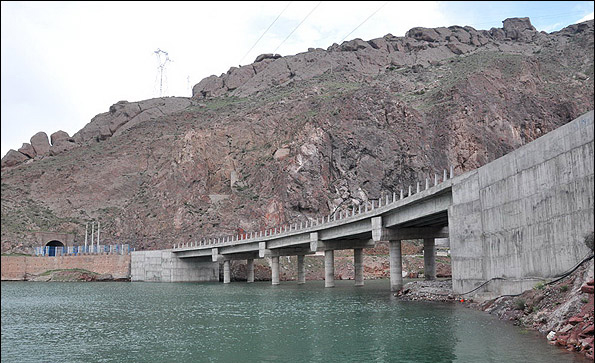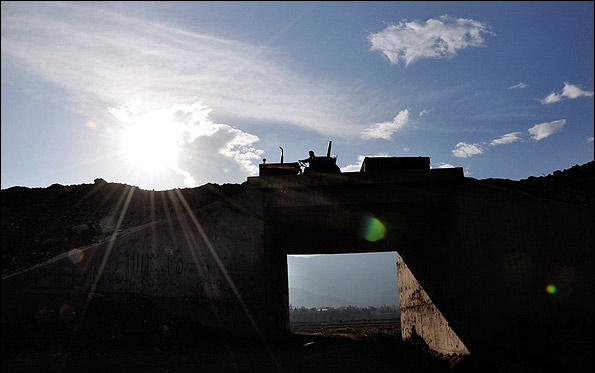By the end of 2015, Azerbaijan and Iran intend to finish the long-delayed rail construction and connect their main railway lines in the border region near the southern shore of the Caspian Sea. Government delegations of the two countries reached the agreement a few days ago. A bridge between Azerbaijani Astara and Iranian Astara, together with connective roads, will become a new railway range which will connect the two neighboring countries and in general the international transport corridor ‘North-South.’
The project of the Kazvin-Resht-Astara railway was included on the agenda in 2005, when the trilateral agreement on construction of the railway line to connect the railway infrastructures of Russia, Azerbaijan and Iran was signed. The railway line had to be built on Iranian territory with an opportunity to be connected with the Azerbaijani and Russian segments. The project was actively supported by the former leadership of Russian Railways (RRW) and Vladimir Yakunin personally. The Russian side had stated many times that it was ready to sponsor part of work on Iranian territory, counting on orders being placed on buying rails from Russian producers.
According to the project, it was planned to build about 350 km of railways with a wheel guage of 1435 mm on Iranian territory. On Azerbaijani territory it is necessary to construct 8 km of connective lines from Azerbaijani Astara to the Azerbaijani-Iranian border. Moreover, both countries should build a bridge across the Astara River together for a railway junction. However, the international anti-Iranian sanctions impeded works and made prospects if new opportunities fade. The crisis in Russia cooled interest in the international transport corridor North-South. RRW is not able to maintain leading positions in the project for several reasons, and Azerbaijan and Iran decided to finish the project which was started 10 years ago together. Moreover, the green light was given in July. The anti-Iranian sanctions may finally be lifted in the near future.
The Iranian side has been building railways for all these years. And today it states that 83% of the railways on its territory are ready. It seems that not much is needed for the last steps, and the final prize may be impressive, while investments will be paid off soon.

How it used to be before…
History and statistics perfectly demonstrate the benefits from a direct railway connection between Russia, Azerbaijan and Iran. In Soviet times there was a corridor between the countries. Those who had the necessary document could easily get from Moscow to Tehran and vice versa by train.
The route passed through Baku on Azerbaijani territory along a bank of the Araz River; it crossed Armenia and ran through the Nakhichevan Autonomous Republic of Azerbaijan. In Julfa, Nakhichevan, the railway had a junction with the Iranian railway – the Iranian Julfa. The overall cargo turnover of Azerbaijani railways in 1988-1989 was about 120 million tons. 100 cargo trains with 50-60 carriages on each were serviced daily. 300-350 cargo carriages passed through Julfa daily. In other words, more than half of the cargo which passed through ARW were directed toward Iran or came from the neighboring country.
So what is happening today? Last year, Azerbaijan Railways CJSC transported a total of 21.8 million tons of cargo, including 9 million tonnes of transit. In retrospect, since 1998 the best Azerbaijan Railways traffic indicator was reached in 2006, when 31.8 million tons were transported by it. At the same time, the current capacity of the road is designed to process up to 100 million tons of cargo. In other words, today only one fifth of the railway transport capacity is being used.
The reasons for this are fairly obvious. First and foremost is the Nagorno-Karabakh conflict and the subsequent occupation of Azerbaijani regions, including those adjacent to the very border with Iran through which the railway passes. As a result, Nakhchevan was included in the transport blockade, and the transport system in Julfa lost contact with the "mainland."
Also we need to keep in mind that a part of those 120 million tons transported by rail before the collapse of the Soviet Union were meant for Armenia too, and they were delivered to regions of the large country. Today the Megri part of the railway in Armenia is hardly used because it isn't connected to the railway infrastructure of the country – the South Caucasus Railway, which is under concession of the company Russian Railways.

Astara is ready for a "transport revolution"
The new transition point in Astara has huge potential for transit cargo. The multi-modal cargo terminal, capable of receiving goods by rail for transhipment by road transport to Iran, is already established on the territory of Azerbaijan and currently it is working effectively. Port facilities for receiving bulk carriers are also being created. Current features of the transhipment point allow for a reloading process of about 600 thousand tons of cargo. These figures are much smaller than the turnover that existed in Soviet times. But if it has already happened once and the North-South corridor has been in demand before, so there is nothing impossible in our days.
In May, Azerbaijan Railways halved tariffs for the Astara direction to attract cargo, which significantly improved the economics of transport, because the carriers, who used the Georgian-Azerbaijani corridor were interested. Iranian cargo started to be transferred to Astara through the Georgian Black Sea port of Poti. Transit of cargo from Russia is also being established. The visit of an Azerbaijan Railways delegation led by Javid Gurbanov to Moscow last week indicated the strong interest of the Russian side in the corridor. Delivery of grain and metals from Russia to the Gulf region through the Southern Iranian port city of Bandar Abbas by rail could be competitive compared with sea shipments through the Suez Canal. By the way, this trend is already being approved in the transportation of cargo to Bandar Abbas from Turkmenistan and Central Asia. The new railway between Kazakhstan and Turkmenistan created a direct route to Iran. But, in comparison with the Azerbaijani road, the Asian one is longer, especially if we take into account the potential flow of goods from/to the European part of Russia or Europe.
Cooperation with Iran may be the most effective direction for neighboring countries, where Azerbaijan and Russia are of primary importance. Azerbaijan, which is the most consistent advocate of a pragmatic approach to Iran, in addition to the construction of the road, is preparing to resume the implementation of dozens of projects frozen under sanctions with its neighbors. The railway along the Caspian Sea may be the first and most important infrastructure project in a year and a half or two years, which will open Iran to the region and the whole world. And what is very important is that there is a minimum from politics and a maximum from economics in it.






